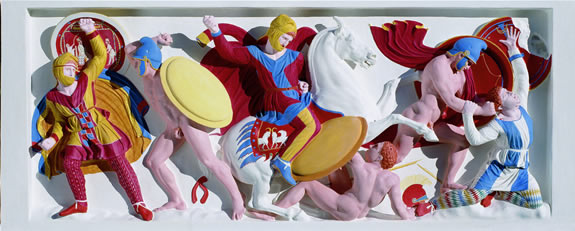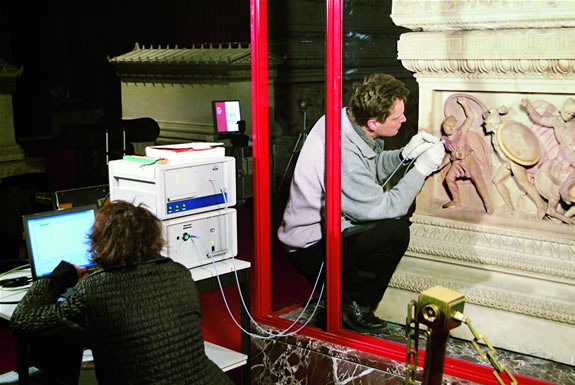Next Gen RP Replicates Ancient Sarcophagus
Archaeologist adopts marble-like materials for creating reproductions of relics.
Latest News
May 22, 2008
By Susan Smith
Who would think that rapid prototyping would find its way into the classical museums of Europe?
A renowned archaeologist’s quest to depict ancient statues as they had actually been produced led to the adoption of versatile marble-like materials that can be used for creating reproductions.

Roman and Greek structures, statues and reliefs have survived wars, climatic and geological change to be admired by thousands of visitors each year. Most people would surmise that the statues and reliefs were never painted because there is generally no paint on them.
Archaeologists know this isn’t true. Classical marble carvings from Rome or Greece would have been painted originally, yet rarely would you find the polychromy to have survived to the present day. Over centuries, paint of any kind has been weathered and eroded off the smooth marble surfaces, leaving virtually no trace of its existence.
A project led by archaeologist Prof. Vinzenz Brinkmann, a leading authority in the field of ancient Roman and Greek art, sought to illustrate how these ancient pieces of art would have appeared in their original, painted form. For this they created reproduction pieces for a special traveling exhibition entitled “Multicoloured Gods,” organized by the Glyptothek Museum in Munich,Germany, the first large-scale effort to recreate the original appearance of ancient Roman and Greek sculpture.
Leading authorities in museums around the world collaborated with international scholars in an effort that represents more than two decades of research on the polychromy of ancient sculpture. Using infrared spectroscopy, paint was recreated using authentic pigments made from natural materials based on findings when analyzing the consistency of the paint fragments found on the original pieces of art.
Needed to illustrate the artwork were replicas of the original statues and reliefs. To create the replicas and replica sections of the ancient statues and reliefs, stereolithography (SL) was used, a process that could employ a material that had qualities similar to marble.
The Alexander Sarcophagus is one of more than 20 full-size colored reconstructions of important Greek and Roman works amassed for the exhibition by Prof. Brinkmann and his team. A stunning center piece, the marble sarcophagus is decorated with bas-relief depictions of scenes of Alexander while he fought the Persians. Archaeologists believe that 4th century BC Lydian King Abdalonymos, an ally of Alexander, had this sarcophagus painted. It is believed that Alexander was painted in a vivid red tunic, magenta cape and golden lion-skin headdress by a well known artist of the time, Nicias. What was unusual about this piece is there were still fragments of color on it when it was discovered in Lebanon.
The restoration of the Alexander Sarcophagus and other pieces presented a specific challenge. First, the team needed to make a replica section of the sarcophagus that was completely precise. Secondly, in order to have an authentic replica, the sarcophagus itself required a material that possessed the hardness and surface qualities of marble.
Due to a complete glass-made housing above the original sarcophagus, the original piece was laser scanned. Because of this limitation, the team did one transverse (shorter side) and longitudinal (longer side) side of the sarcophagus.
Scanning technology was used to generate a three dimensional data set, which was the basis for a 3D file which could be used for producing the replica using SL. In the process of SL, a liquid photopolymer material would be selected to create the 3D prototype directly from the digital 3D file.
Prof. Brinkmann’s team chose Alphaform AG, a German based specialist service bureau that specializes in rapid prototyping, to reproduce the part. From Alphaform’s point of view, the project was challenging. “These kind of projects are far removed from our usual rapid prototyping work, for example, for automotive and Formula 1 where we receive well designed files with good surfaces,” noted Alphaform Director Ralf Deuke.
Even so, Alphaform was not entirely new to the process of creating fine art and reproductions. They have been responsible for creating art for renowned artists such as Andrew Barov and the “Bayrische See- und Schlösserverwaltung” — an institution which preserves pieces of art and ancient buildings in the south of Germany.
“The project generated a number of specific challenges: The scan contained a lot of defects due to a combination of the protective glass cover and the space limitations around the original piece in the Istanbul museum,” continued Deuke. “Another big challenge was that the file generated thousands of supports. Some structural supports are necessary while the part is being manufactured using the SL process but not thousands! We therefore had to use our experience and know-how to find a good compromise and produce a file that the machines were able to handle and which showed minimal defects.”
Ultimately, Deuke said they used the Materialise Magics software, “which did an incredibly good job, but there were still hours of work for build preparation. By using the Magics software we reduced the data size and each time checked on very critical and fine detailed parts of the piece and whether all the details were still present. We stopped when we started seeing errors or triangles.”

Reproducing the fine detail of the piece as accurately as possible required an SL material with hardness and surface qualities similar to marble. Alphaform decided to use SL rather than laser sintering techniques ]SLS] because of its superior surface finish and detail resolution, plus they needed a material that could reproduce mineral-like qualities. The SL photopolymer NanoTool from DSM Somos, a high modulus material designed for high-end engineering applications, fit the bill. Used in automotive and wind-tunnel testing as well as for rapid tooling, NanoTool is heavily filled with non-crystalline nanoparticles which lend itself to faster processing. Being a virtually zero shrinkage polymer, build lines don’t detract from the smooth finish. “Due to the nature of the DSM Somos Nanotool material, the buildlines that normally are pretty well visible did not show up as much as they would when using another material; this was one of the reasons why we have chosen Nanotool material,” said Deuke.
“We have a lot of experience with NanoTool for the rapid prototyping of F1 aero sections and other parts that need high surface quality,” continued Deuke, “it provides extremely fine detail resolution compared to other SL materials. Professor Brinkmann evaluated the material and found it easy to finish and paint - far superior to the plaster normally used to create replicas.”
“After first creating a small section less than half a meter wide we moved on to replicating a full three meter side of the sarcophagus. The complete piece was built in three sections which were then seamlessly fitted together. Without rapid prototyping it would have been impossible to create this part. It’s ironic that a material and process designed for next generation prototyping and manufacture has replicated a 2,500 year old sarcophagus!”
In this case, fragments of pigment on relics of the past, combined with cutting edge technology and photopolymer materials, reveal a possibly more accurate depiction of ancient art than ever imagined.
Located in Munich, the GlyptothekMuseum houses a collection of Greek and Roman sculpture owned by the Bavarian state. The building, commissioned by King Louis I of Bavaria and designed in the Neoclassical style by Leo von Klenze, was erected 1816–30.
From Munich, the “Multicoloured Gods” exhibition is touring major European cities and the U.S.
DSM Somos
Elgin, IL
Subscribe to our FREE magazine, FREE email newsletters or both!
Latest News
About the Author
DE’s editors contribute news and new product announcements to Digital Engineering.
Press releases may be sent to them via [email protected].






